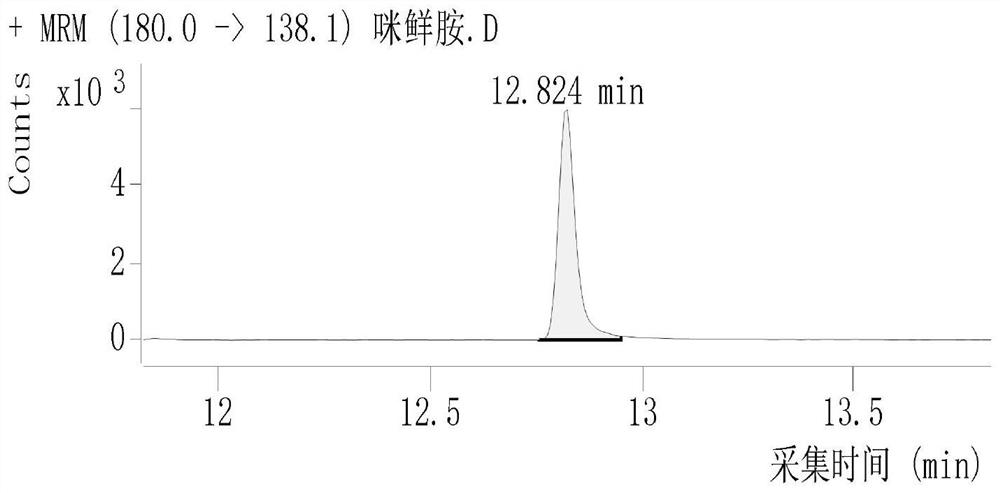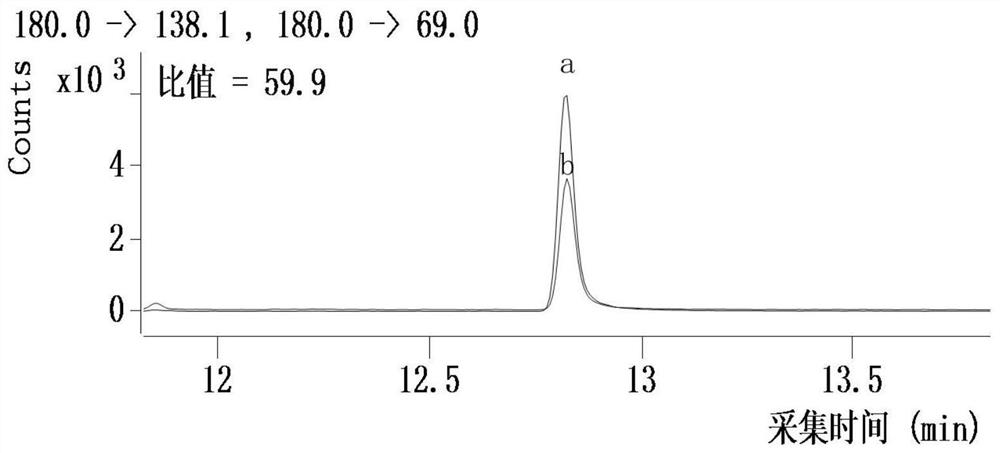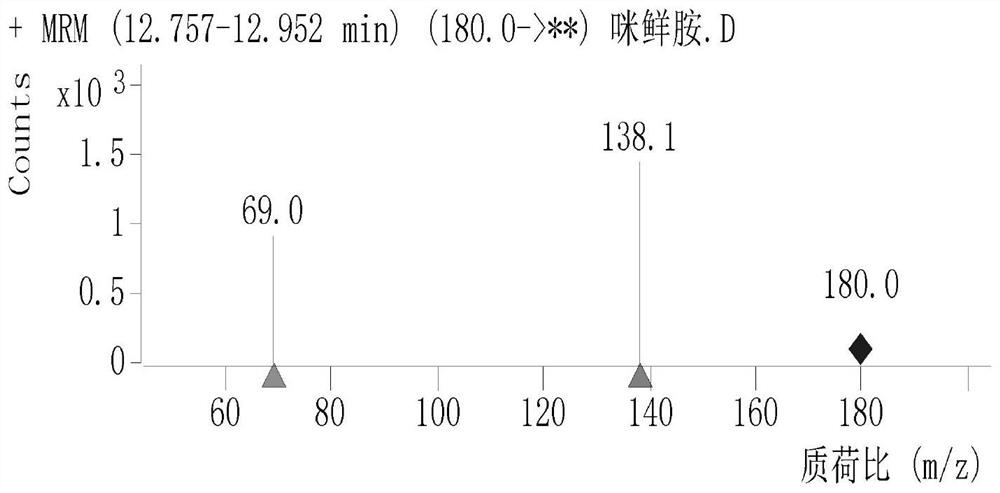Method for determining residual quantity of prochloraz and metabolite thereof in cereal grains and application
A technology of prochloraz and metabolites, which is applied in the field of determination of prochloraz and its metabolites residues in grains, can solve the problem of ineffective removal of fat, etc., and achieve the effect of eliminating matrix effect, strong matrix effect and low cost
- Summary
- Abstract
- Description
- Claims
- Application Information
AI Technical Summary
Problems solved by technology
Method used
Image
Examples
Embodiment 1
[0054] Embodiment 1: Determination of prochloraz and its metabolite residues in rice
[0055] (1) Extraction of samples: Weigh 5g (accurate to 0.01g) of rice powder that has been crushed and mixed through a 425μm standard mesh sieve into a 50mL stoppered centrifuge tube, add 10mL of experimental water, vortex and mix well, and then soak After 30 min, add 10 mL of 1% acetic acid acetonitrile, 1 g of sodium acetate, and 3 g of sodium chloride, cover the bottle cap, vibrate vigorously for 1 min, and sonicate for 10 min, then centrifuge at 4000 r / m for 3 min, and let it stand for purification;
[0056] (2) Purification of the sample: Take 5 mL of the above centrifuged supernatant in a 10 mL test tube, add 200 mg PSA and 150 mg C18, vortex for 1 minute, centrifuge, take 3 mL of the supernatant and purify it in a 10 mL test tube containing 1000 mg EMR purifier , vortex, and centrifuge to take the supernatant through a 0.22 μm organic filter membrane and bottle it for testing;
[00...
Embodiment 2
[0064] Example 2: Determination of prochloraz and its metabolite residues in corn
[0065] (1) Sample extraction: Weigh 5g (accurate to 0.01g) of corn flour that has been pulverized and mixed through a 425μm standard mesh sieve into a 50mL stoppered centrifuge tube, add 10mL of water, vortex and mix well, soak for 30min, add 10 mL of 1% acetic acid acetonitrile, 1 g of sodium acetate, and 3 g of sodium chloride were placed on the bottle, shaken vigorously for 1 min, ultrasonically 10 min, and centrifuged at 4500 r / m for 5 min.
[0066] (2) Purification of the sample: Take 3 mL of the above centrifuged supernatant in a 10 mL test tube, add 200 mg PSA and 150 mg C18, vortex for 1 minute, centrifuge, take 2 mL of the supernatant in a 10 mL test tube containing 1000 mg EMR purification agent Purify, vortex, and centrifuge to take the supernatant and pass it through a 0.22 μm organic filter membrane before bottling;
[0067] (3) The preparation of matrix mixed standard series workin...
Embodiment 3
[0074] The comparative experiment of embodiment 3 different extraction solvents
[0075] Purchase oat, wheat, rice, corn, and brown rice samples from the market, use acetone, acetonitrile, ethyl acetate, n-hexane, and 1% acetic acid acetonitrile as extraction solvents to extract the above samples, and then test, the processing and testing of the above samples All were carried out according to the operation steps in Example 1, except that the extraction solvent was replaced during the operation. The recoveries of 2,4,6-trichlorophenol and prochloraz in each sample under different extraction solvents are shown in Table 3.
[0076] The recoveries of samples under different extraction solvents in table 3
[0077]
[0078] It can be concluded from the data in the above table that in the embodiment of the present invention, the recovery efficiency of prochloraz and metabolites using 1% acetic acid acetonitrile as the extraction solvent is the highest, and the recovery result is ...
PUM
| Property | Measurement | Unit |
|---|---|---|
| pore size | aaaaa | aaaaa |
| collision energy | aaaaa | aaaaa |
| pore size | aaaaa | aaaaa |
Abstract
Description
Claims
Application Information
 Login to View More
Login to View More - R&D
- Intellectual Property
- Life Sciences
- Materials
- Tech Scout
- Unparalleled Data Quality
- Higher Quality Content
- 60% Fewer Hallucinations
Browse by: Latest US Patents, China's latest patents, Technical Efficacy Thesaurus, Application Domain, Technology Topic, Popular Technical Reports.
© 2025 PatSnap. All rights reserved.Legal|Privacy policy|Modern Slavery Act Transparency Statement|Sitemap|About US| Contact US: help@patsnap.com



